Spring is Coming - Plans for Our Third Garden
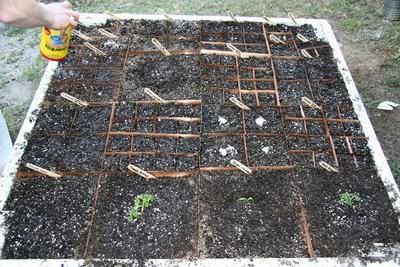
"...the sun looks on our cultivated fields and on the prairies and forests without distinction. They all reflect and absorb his rays alike, and the former make but a small part of the glorious picture which he beholds in his daily course. In his view the earth is all equally cultivated like a garden. Therefore we should receive the benefit of his light and heat with a corresponding trust and magnanimity..."
--Henry David Thoreau in Walden, "The Bean Field."
Our First Garden:
Back in 1998, we made an attempt at our first garden after purchasing a house. This was in Concord NC just outside of Charlotte. We had a large flat treeless backyard with too much sun, no shade. The soil was rocky, somewhat sandy and clay-like, having been trucked in from who knows where in about 1990 according to our neighbors who were the first to live in that neighborhood. We dug out first a polygonal quasi-triangular corner plot bordered with bricks and about 8-12" deep, perhaps 75square-feet in area and amended the soil with perlite, peat-moss, and various "soil conditioners in a rather haphazard way. We created another rectangular plot roughly 2feet by 14 feet bordered with bricks, but shallower, about 6inches deep. Between my wife and me we might have read 1-1/2 gardening books at that time. We planted partially grown tomato and pepper plants (about 8) in the large triangular plot, a few more tomato plants and strewed some giant Russian sunflower seeds along most of the rest of rectangular plot. We fertilized using synthetic stuff (blue Peter's powders) and plentiful tap water using sprinklers. By the end of the summer we had so many tomatoes we let most of it rot on the vine. The giant sunflowers grew to a fearsome height as the following picture shows:
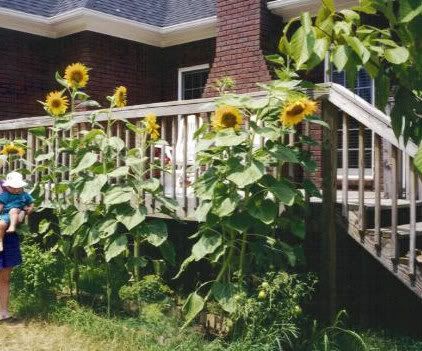
After many years, we decided to try a vegetable garden again this year. By now my wife and I have read probably a dozen or so gardening books. The best of which is probably Mel Bartholomew's Square Foot Gardening. I like his engineer's sensibility to gardening. He describes every detail of setting up and cultivating a garden and doesn't throw out the usual trite and unuseful homilies like "water an inch" - (what the hell does an inch mean, unless you specify the conditions and the containers which enclose that inch?). His book is greatly recommended as is his website.

After many years, we decided to try a vegetable garden again this year. By now my wife and I have read probably a dozen or so gardening books. The best of which is probably Mel Bartholomew's Square Foot Gardening. I like his engineer's sensibility to gardening. He describes every detail of setting up and cultivating a garden and doesn't throw out the usual trite and unuseful homilies like "water an inch" - (what the hell does an inch mean, unless you specify the conditions and the containers which enclose that inch?). His book is greatly recommended as is his website.
Late Winter Pre-Gardening
To gain an advantage over nature, I set up a mini-greenhouse using an old 55gallon fish tank and 2 fluorescent lights (80Watts of about 6000K light 14hours/day). I put aluminum foil over the back to reflect light and tried to raise the seedling dishes toward the light. I figured the tank with top should retain moisture and the lights should be adequate:
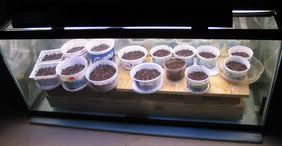
It turns out we either didn't have the inclination or time to care for these seedlings well as they grew tall and sickly and rootbound and fell over before we had a chance to re-pot them. Hopefully the pepper seedlings might make it as they are the most crucial time-wise.

To gain an advantage over nature, I set up a mini-greenhouse using an old 55gallon fish tank and 2 fluorescent lights (80Watts of about 6000K light 14hours/day). I put aluminum foil over the back to reflect light and tried to raise the seedling dishes toward the light. I figured the tank with top should retain moisture and the lights should be adequate:

It turns out we either didn't have the inclination or time to care for these seedlings well as they grew tall and sickly and rootbound and fell over before we had a chance to re-pot them. Hopefully the pepper seedlings might make it as they are the most crucial time-wise.

Following Mel Bartholomew's advice:
I made a wooden box using 4 pieces of 2"x8"x10' fixed at the corners, then painted with latex for some weatherproofing. For the bottoms, I used composite board (extremely expensive) and screwed on the bottom with 1/4" spacing between for drainage. We painted the box, then let it dry a week.
Here's my daughter helping paint the box:

My wife and I lay the box out over cinderblocks and dirt and gravel to level it the best we could on a hill (we live on a steep hill). I stapled in black landscaping fabric to the bottoms and sides of the box to act as a filter, then dumped in 4cubic feet of perlite, 10x 2-1/2 gallon bucks of all-purpose sand, almost 6 cubic feet of peat moss, about 4 cubic feet of mushroom compost, 4 cups of pelletized lime, 4 cups of "organic" chicken manure. Mixed and watered the mixtured as per directions, then covered the whole box with a large square of clear plastic to "heat" the soil for planting.

Our plans are to plant 3 tomato seeds ( 1 cherry, 2 beefsteak), 1 pepper, 16 carrots, 16 onions, Swiss Chard, Romaine lettuce, Basil. I plan on building a cage of tomato wire and chicken wire to ward off squirrels, rabbits, cats, and cover the cage with clear plastic for frosts. We'll see how this project turns out. My wife and I have proven ourselves to be rather careless gardeners in the past. Here's the breakdown in cost of the project thus far:
I made a wooden box using 4 pieces of 2"x8"x10' fixed at the corners, then painted with latex for some weatherproofing. For the bottoms, I used composite board (extremely expensive) and screwed on the bottom with 1/4" spacing between for drainage. We painted the box, then let it dry a week.
Here's my daughter helping paint the box:

My wife and I lay the box out over cinderblocks and dirt and gravel to level it the best we could on a hill (we live on a steep hill). I stapled in black landscaping fabric to the bottoms and sides of the box to act as a filter, then dumped in 4cubic feet of perlite, 10x 2-1/2 gallon bucks of all-purpose sand, almost 6 cubic feet of peat moss, about 4 cubic feet of mushroom compost, 4 cups of pelletized lime, 4 cups of "organic" chicken manure. Mixed and watered the mixtured as per directions, then covered the whole box with a large square of clear plastic to "heat" the soil for planting.

Our plans are to plant 3 tomato seeds ( 1 cherry, 2 beefsteak), 1 pepper, 16 carrots, 16 onions, Swiss Chard, Romaine lettuce, Basil. I plan on building a cage of tomato wire and chicken wire to ward off squirrels, rabbits, cats, and cover the cage with clear plastic for frosts. We'll see how this project turns out. My wife and I have proven ourselves to be rather careless gardeners in the past. Here's the breakdown in cost of the project thus far:
Lumber:
4 of 2"x8"x10' - $9.58 x 4 = $41
4 of 8' length of composite board - $23 x 4 = $98.50
Soil:
peat moss 3.8CF for $7.53 - 2 bags = $16.11
perlite 4 CF for $16.99 = $18.18
sand 60lbs (5gallons) for $2.94 - 5 bags = $15.73
mushroom compost 40lb bag for $3.99 - 6 bags = $25.62
lime 40lb pelletized bag for $2 = $2.14
chicken manure 40lb bag for $5.99 = $6.41
woodashes/charcoal - can't find
Wire/Fencing:
chickenwire 50' of 24" $7.93 = $8.49
Seeds: .97 - $1.49 per packet = $10.70
Misc:
paint brushes, paint: $20.81
large turnable 60gallon enclosed composter: $139.09
Total costs: $402.78 - AMEXgift check (100) - gardencenter giftcard(33) = $269.78
additional expense to be spent: metal supports for tomatoes/peppers, tomato wire for protection: ~$30
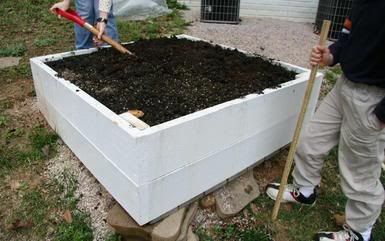
The only way to justify this nearly $300 of net expenditure would be that we will use this set-up every year for at least 5 years and that the produce resulting will be healthier, cleaner, safer, etc. And that it will provide therapeutic and life-enhancing benefits unquantifiable otherwise. We could have spent much less for material - for example, we could have just fixed up a compost pile using discarded pallet crates for free (saving $139.09), and we could have used scrap lumber and no composite board (saving $100-$141) but we were thinking we will use this method and materials annually thus the investment in lasting materials was considered worthwhile. Also as noted above, my wife had a couple of giftcards worth $133 which helped reduce this expense from over $400 to under $300.
Organic Produce - What are the issues and is it worth it?
Of course you'd have to compare the cost of the vegetables (assuming we get results from our garden) only with good "organic" produce from a place like Whole Foods. If you investigate the benefits of organic produce, you can find as many negatives as positives. Here's a page framing the debate. Does the price of organic produce justify the benefits? Maybe not - the main benefit of organic produce which does hold up to scrutiny is that in general organic produce tend to have significantly less synthetic pesticides like organophosphates. The organic producers tend to downplay the fact that organic produce however contains significantly higher amounts of organic pesticides which can be also toxic to humans. It also raises the question, why is organic produce contaminated with pesticides at all? One fairly done study shows that ~25% of organic produce is contaminated with the synthetic pesticides which were measured. This is probably because these residues are present in our water table, in the air from overhead spraying, and in the general environment - can we avoid organophosphates and other pesticides at all? I'd say no - it's simply a matter of quantity of exposure. Is it worth paying x times as much for produce for a questionably lower levels of only certain types of pesticides? Also, can we trust "organic" farmers to be assiduously meticulous and conscientious about their farming methods? And can we trust the federal inspectors to properly certify various farms as "organic?" - probably there is a lot of corruption and/or laziness here also.

I know that there is a great deal of money being made in the organic certification process and in general this organic certification business is necessary - yet I can't help but be extremely skeptical about the whole process. I suspect there is a whole lot of bullshit going on in this business, as much if not more than in the meat industry.
The entire pesticide issue has become laden with an eco-terrorist zeal which becomes increasingly uncomfortable to debate. I like the general liberal approach to our world and ecology, but this is one issue where opinions like this and this needs to be more prominently pushed. And organic people tend to lose sight of the fact that produce contaminated with fecal organisms (from "organic fertilizers" like manure) is probably a greater danger to our health than synthetic pesticides - also read this reasonable overview article about some of the points in the debate in general. This is why cultivating your own garden as Voltaire suggested is probably the best way to reduce all the concerns on both sides of the issue.
Summary From My personal Garden Price Book
I did examine the total costs of the material by "price-booking" at the following stores: Lowe's, Walmart Garden section. Basically the only places you could find decent stuff was Lowe's, Home Depot, and Logan's Trading Co. Logan's Trading Co. was almost always more expensive, the Lowe's and Home Depot had pretty much the same price on everything. The local garden stores had everything priced exorbitantly - the only reason we bought a lot of stuff at Fairview was because of our gift card which could not be cashed.. Here's the price book breakdown on the main ingredients:
..................Lowe's..........Home Depot....Logan's Trading Co......Fairview
pbarkmulch.......(1.16/cf)...........(.94/cf).................(1.26/cf)..............(2/cf)
peatmoss.............(1.98/cf).........(1.98/cf).............(3.42/cf)...............(2.7/cf)
perlite...................(.36/qt).............(.37/qt).................(.14/qt)..............n/a
sand....................(.053/lb)..........(.049/lb)...............(.08/lb)................n/a
m.compost...........3.97/40lb.........2.85/40lb...........5.99/40lb.............n/a
pell.lime...............2.23/50lb.........2.00/50lb...........4.49/40lb..........6.99/40lb .
wood..............2"x8"x10' 9.58.....2"x8"x10' 9.58...........n/a.................n/a
seeds................0.97/packet................................1.69/packet.....1.09/packet
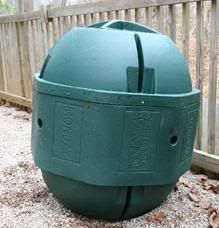
Our composter was a "gazingus pin" which we thought was a good investment after reading about composters in various books and looking at online information like this. In speaking with friends and neighbors, composting out in the open attracted squirrels, raccoons, rats, cats, dogs, and other even worse night animals - manually turning the compost with a shovel or fork was also apparently back-breaking labor. Our Canadian-made turn-o-matic enclosed composter was a breeze to turn, had a tight lid which was animal proof, and kept the compost discretely. In pricing various composters of this size online like this one or this one we decided the one we bought (from Logan Trading Co) was a good deal. In general, I would recommend that all triangle area gardeners flock to Logan's Trading Company for their rich store of gardening material and supplies, however, one should be aware that you pay more for the basic supplies. I'd hate to see this company go out-of-business so I'd be willing to spend extra to keep them around. If you look at many of the prices at Lowe's Hardware and Home Depot - one can't help to wonder they arrive at such similar pricing - either they are blatanly in cahoots with each other to fix prices, or one or both have price spies to keep their products priced in line with the other.